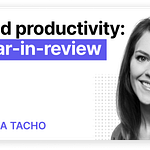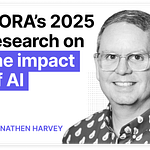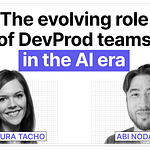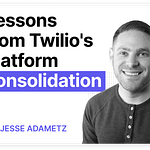Listen and watch now on YouTube, Apple, and Spotify.
In this episode, I talk with Bruno Passos, Product Lead for Developer Experience at Booking.com, about how the company is rolling out AI tools across a 3,000-person engineering team.
Bruno shares how Booking.com set ambitious innovation goals, why cultural change mattered as much as technology, and the education practices that turned hesitant developers into daily users. We also discuss the early barriers, from low adoption and knowledge gaps to procurement hurdles, and the interventions that worked, including learning paths, hackathon-style workshops, Slack communities, and centralized procurement. Today, Booking.com is already in the top 25 percent of companies for AI adoption.
Some takeaways:
Booking.com’s goals for AI adoption
The goal was to accelerate development and remove toil. Engineers could spend more time on innovation instead of maintenance.
Booking.com set an ambitious “innovation ratio.” They aimed for 80–90% of engineer time on creative work, compared to a global top 10% benchmark of 65%.
AI was also a lever for modernization. Even with a legacy codebase, leaders believed it could help re-platform, clean up technical debt, and shorten cycle times.
The mindset was experimental from the start. AI wasn’t introduced because it was trendy but as a series of controlled experiments to uncover real business value.
Building adoption through enablement
Adoption grew only after targeted enablement. Curated learning paths and structured training helped developers build confidence.
Two-day learning sprints became a turning point. Day one focused on prompt engineering and context handling, while day two paired developers with real business problems.
Developers brought their own problems to hackathons. This made training immediately relevant and produced artifacts that solved real issues.
Experience-based accelerators (EBAs) scaled the model. In these 3–5 day focused sessions, developers worked cross-functionally with providers, and about 70% of the code produced was AI-assisted.
Providers were treated as partners. Booking.com invited tool vendors to embed with teams, share expertise, and help tackle specific business challenges.
Driving cultural change
AI adoption required cultural as well as technical change. Simply granting licenses didn’t work; Booking.com needed to integrate AI into its development culture.
Leadership enablement was crucial. Leaders who experienced AI firsthand became stronger advocates for adoption across their business units.
Coding sessions with leaders built momentum. These sessions energized managers, who returned to their teams pushing for wider use.
Slack communities lowered friction. Developers felt more comfortable asking questions in Slack than in formal settings, which revealed education gaps and sped up problem-solving.Cross-unit collaboration improved. AI became a catalyst for teams across different business units to work together more closely.
Measuring impact while key questions remain
Early “hours saved” metrics weren’t enough. Surveys about time savings were too subjective and based on too few users.
Booking.com shifted to broader measures. They focused on speed, efficiency, quality, cycle time, and re-platforming progress.
AI users created more—but lighter—merge requests. Daily users produced 30% more MRs that were 70% smaller, but it is not yet clear whether this improves quality or efficiency.Human review remains essential. Every MR still requires two reviewers, which protects against poor code slipping through.
Key questions remain open. Is AI-assisted code more readable, efficient, and secure? Does it reduce bugs and vulnerabilities? These answers are still undetermined.
Unblocking organizational bottlenecks
Procurement and risk reviews slowed down experimentation. Developers wanted to try every new AI tool, but legal and security created friction.
A central “committee” was formed to unblock adoption. This group reviewed requests weekly, streamlined approvals, and prevented each business unit from duplicating effort.
Fast-tracking proofs of concept became a priority. Developers could get hands-on with new tools sooner, while procurement caught up in the background.The platform mindset helped. Booking.com treated AI like any other developer tool, centralizing pain points and ensuring consistency across the company.
Tracking current adoption trends
60% of developers now use AI tools. This places Booking.com in the top 25% of companies globally for adoption.
Daily users ship more frequently. Developers using AI at least three times a week create 30% more merge requests.
Usage patterns are evolving. While more MRs are being created, many are lighter, and Booking.com is still investigating what that means for long-term quality.
Adoption is uneven across units. Some business units are ahead, while others are still cautious, reflecting differences in culture, legacy systems, and leadership buy-in.
In this episode, we cover:
(00:00) Intro
(01:09) Bruno’s role at Booking.com and an overview of the business
(02:19) Booking.com’s goals when introducing AI tooling
(03:26) Why Booking.com made such an ambitious innovation ratio goal
(06:46) The beginning of Booking.com’s journey with AI
(08:54) Why the initial adoption of Cody was low
(13:17) How education and enablement fueled adoption
(15:48) The importance of a top-down cultural change for AI adoption
(17:38) The ongoing journey of determining the right metrics
(21:44) Measuring the longer-term impact of AI
(27:04) How Booking.com solved internal bottlenecks to testing new tools
(32:10) Booking.com’s framework for evaluating new tools
(35:50) The state of adoption at Booking.com and efforts to expand AI use
(37:07) What’s still undetermined about AI’s impact on PR/MR quality
(39:48) How Booking.com is addressing lagging adoption and monitoring churn
(43:24) How Booking.com’s Slack community lowers friction for questions and support
(44:35) Closing thoughts on what’s next for Booking.com’s AI plan
Where to find Bruno Passos:
• LinkedIn: https://www.linkedin.com/in/brpassos/
• X: https://x.com/brunopassos
Where to find Laura Tacho:
• LinkedIn: https://www.linkedin.com/in/lauratacho/
• Website: https://lauratacho.com/
• Laura’s course (Measuring Engineering Performance and AI Impact) https://lauratacho.com/developer-productivity-metrics-course










